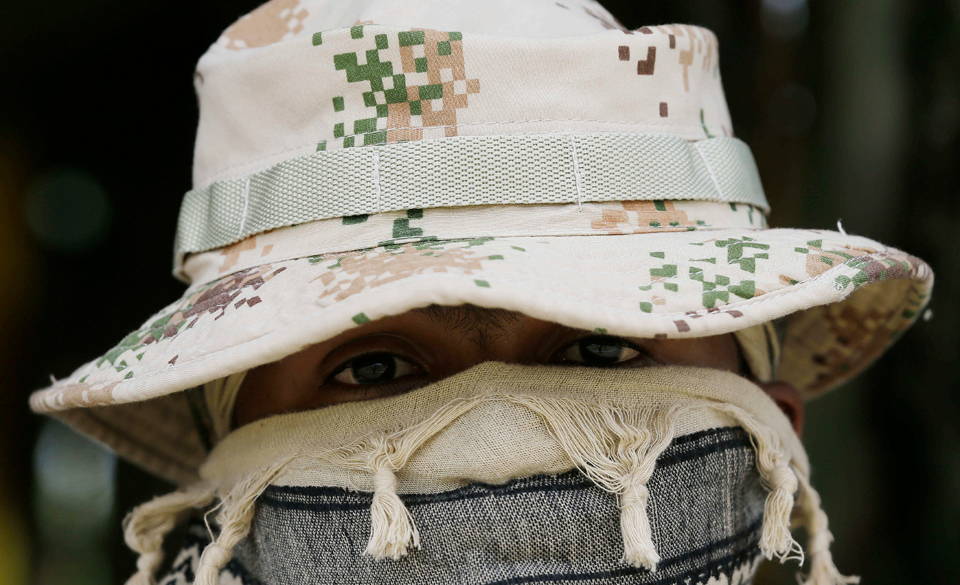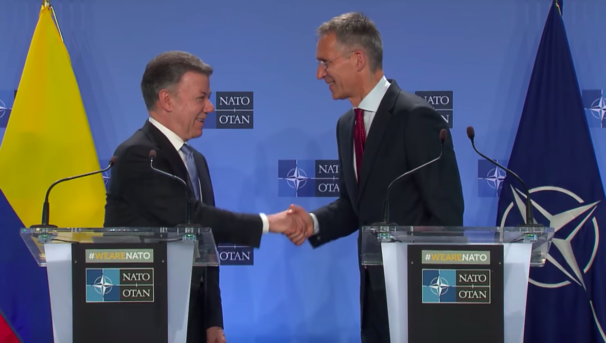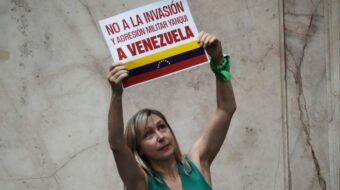
It was no surprise. Already Colombia had sent personnel to military training schools in Germany and Rome and troops to the Horn of Africa to fight Somali pirates, all under the auspices of the North Atlantic Treaty Organization. Already, in 2013, Colombia and NATO had agreed to cooperate in intelligence-sharing, military-training exercises, and so-called humanitarian interventions. And in May 2017, Colombia and NATO agreed that the former would become a NATO “global partner.”
On May 25, 2018, Colombian President Juan Manuel Santos made an announcement to that effect. He mentioned too that Colombia was joining the Organization for Cooperation and Economic Development, “an international club of creditors of deeply indebted poor countries,” according to one observer. Within a few days, Santos was conferring in Brussels with NATO Secretary General Jens Stoltenberg.
Colombia thus becomes NATO’s first global partner in Latin America. Those in other regions include Afghanistan, Iraq, Pakistan, New Zealand, Japan, Mongolia, and South Korea. But planning for Colombia’s association with NATO apparently preceded that for the seven other nations. As a global partner, Colombia isn’t bound by Article 5 of NATO’s founding treaty of 1949 which declares that an attack on one member state is an attack on all of them, something applying to the 29 fully-fledged members.
The job description of a global partner, according to the NATO website, is to “develop cooperation with NATO in areas of mutual interest, including emerging security challenges, and some [partners] contribute actively to NATO operations either militarily or in some other way.” Thus an “intimate bond between the country and the structure of NATO” involves “close collaboration in most military areas.”
Colombia boasts two qualifications for associating with NATO. One, it’s a regional military power. Representative numbers tell that story: Colombia’s military force includes 550,550 troops (369,100 active duty), 273 helicopters, 1,345 armed fighting vehicles, and $8.976 billion in budgeted military spending for 2017. Only Brazil, at $25.75 billion, exceeds Colombia in this regard in Latin America. The Colombian government spends 13.1 percent of its total outlay on military spending, which accounts for 3.4 percent of Colombia’s GDP, the highest such rate in South America, says a source citing a percentage of 3.1.
Secondly, Colombia’s relations with a powerful sponsor are tight. The bond between the United States and Colombia has persisted since 1948 when Bogotá hosted the conference at which the Organization of American States took shape, since 1951 when the “Colombian Battalion” joined U.S. troops in the Korean war (alone among Latin American soldiers), since 1962 when U.S. military advisors in effect turned Colombia’s counter-insurgency effort over to paramilitaries thereby sowing seeds of murder and chaos, since the 1980s when common purpose in dealing with illicit drugs first emerged, since 2000 when billions of dollars in military aid started to flow under Plan Colombia, and since 2009 when arrangements for seven U.S. bases in Colombia were finalized.
Colombia enters a NATO where its U.S. patron has exerted leadership at the highest level. Partnership between the United States and Colombia, resting on shared commercial and economic interests of the dominant social classes of both countries, now plays out within a militarized, multi-national entity that protects such interests.
A dreadful duo thus has the back of Colombia’s oligarchy. The prospect is good that new grief will be falling upon the underclass not only in Colombia, but also in the region and farther afield.
Criticism centers on facades obscuring possible NATO and U.S. militarized interventions in Colombia and Latin America generally. These include operations like humanitarian assistance, fighting illicit drugs, and countering alleged terrorism. Intelligence sharing and standardization of military equipment can be expected.
There is speculation that a NATO-U.S. alliance may lead to new impediments to struggles in Colombia for justice and peace. It will “fence in possibilities for social transformation,” says one analyst. With NATO on the scene, the government’s zeal for implementing the recent peace agreement with the FARC, enfeebled already, may weaken even more. And Colombia’s army and paramilitary forces may soon be acting “like a praetorian, imperial guard in the region controlling all the narco-trafficking in the region.”

There is worry too that with NATO’s intrusion in Latin American affairs, recent advances toward regional unity may be doomed. The presence of NATO, real or imagined, may cancel out or damage regional alliances that deal with social programs, or promote mutually beneficial trade arrangements, or foster military and diplomatic cooperation. The prototype of the latter has been the Latin America and Caribbean Economic Community (CELAC), with its mission of ameliorating conflict among member states. In retrospect, CELAC’s declaration of January 2014 in favor of a “Zone of Peace” looks now like wishful thinking.
President Santos has come under serious criticism, for example, that “he brings to a peaceful and denuclearized region like Latin America and the Caribbean a weapon [capable] of mass destruction of peoples and states like NATO.” And according to Venezuela’s foreign ministry, Colombian authorities now “lend themselves to introduce, in Latin America and the Caribbean, a foreign military alliance with nuclear capacity, which in every way constitutes a serious threat for peace and regional stability.” That has meaning, says another observer, especially “along the borders of progressive states like Venezuela and Ecuador.”
Lastly, claims are heard that Colombia’s now close association with NATO represents a fundamental shift in U.S. strategies for global control. Formerly, and especially during the Cold War, NATO leaders targeted Soviet Russia ostensibly because of its communist government. For reasons that are less clear, but having to do generally with control, NATO undertook to encircle post-Soviet Russia. While engaged in the Middle East and Afghanistan, NATO had its eyes on Russia too.
Now, however, NATO has a Western Hemisphere ally with a coastline and ports on the southern reaches of the Pacific Ocean. U.S. machinations may have accounted for Colombia joining NATO, and, if so, with a rationale. At least one analyst there thinks that “China seriously threatens the political economic, military, and cultural hegemony of the United States.” In fact, he says, the Pacific Ocean is “today the most important battlefield of the Second Cold War.” And “for imperialist plunderers of the 21st Century, Colombia has become the point of their sword.”










